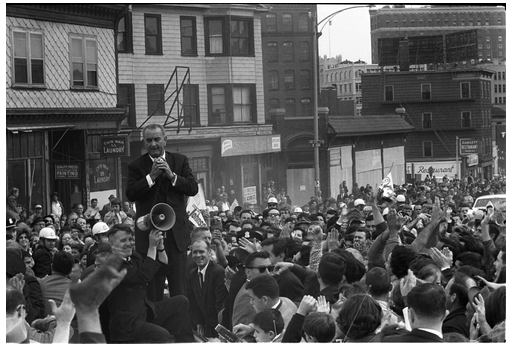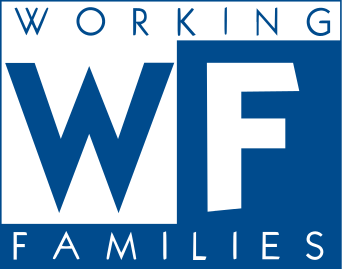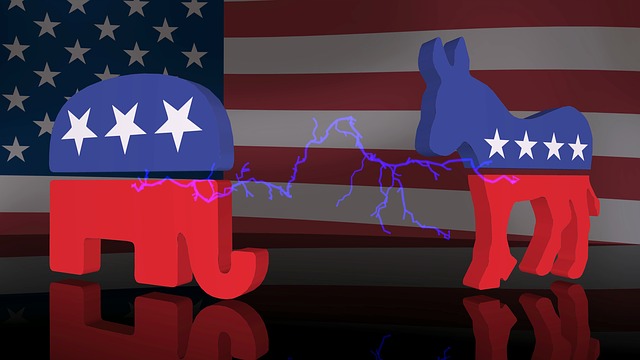

Describe the role of political parties in elections at the state and national levels. (Massachusetts Curriculum Framework for History and Social Studies) [8.T3.5]

Political parties can be defined as "a group of people who share the same ideas about how the government should be run and what it should do" (League of Women Voters California Education Fund, 2013, para. 2). Mention the term political party and many people think of today's two major parties and their animal symbols—the Democrats' donkey (which first appeared during Andrew Jackson's 1828 Presidential campaign) and the Republicans' elephant (first drawn by political cartoonist Thomas Nast in 1874). You can learn more at "How Did the US Political Parties Get Their Mascots" from Wisconsin Public Radio (November 8, 2016). For other people, political parties mean sharply different visions for how American society should be organized and they align themselves with the party that matches their viewpoint. The Gallup Poll reports that in 2019, 27% consider themselves Democrats, 26% Republicans, and 46% Independents or not aligned to any party (Gallup, 2019). Members of a political party work together to win elections and influence the making of public policy. Political parties are much more than promotional symbols or ideological home bases for policy-interested voters. Political parties determine the candidates for President, members of Congress, and many state and local positions. They establish the majority party/minority party organization of Congress. They raise enormous sums of money to support those running in state and local elections. They influence policy through political advocacy and public information campaigns. What are different ways that political parties function within the nation's political system? The modules for this standard explore that question by examining the evolution of the political party system, the roles of third parties and radical political parties at different times in history, and the question of whether every voter should join a political party.
Political parties have been part of the U.S. political system since the nation's founding, beginning with debates over the federal Constitution of 1787 between the Federalists (led by Alexander Hamilton) and the Anti-Federalists (led by Thomas Jefferson). Party divisions and rivalries have continued ever since, despite George Washington's warning in his Farewell Address on September 19, 1796:
"It [party conflicts] serves always to distract the public councils and enfeeble the public administration. It agitates the community with ill-founded jealousies and false alarms; kindles the animosity [hatred] of one part against another; foments [provokes] occasionally riot and insurrection."
Since just before the Civil War, American politics has been dominated by "two large-tent parties battling for primacy against each other, but often battling themselves" (Tomasky, 2020, p. 60). Evolution of Political Parties in American Politics offers an overview of the party system. This Political Party Timeline Prezi features a historical overview of political parties in American politics.
According to Ballotpedia, there were 225 recognized political parties in the United States during the 2020 election.

A recognized political party is an organization that has followed a state's rules for being on an election ballot. The Democratic and Republican Parties appeared on the ballot in all 50 states and the District of Columbia, accounting for 102 of the 225 recognized parties. The Libertarian Party appeared in 35 states, the Green Party in 22 states, and the Constitution Party in 15 states.
The resourcesforhistoryteachers wiki page, The Conservative Movement in American Politics, charts the rise of conservative politics since 1980 and includes material on the Tea Party.
The Democrats and the Republicans
Contemporary American politics is dominated by the Democratic and Republican political parties. We often refer to states or Congressional election districts as red (Republican) or blue (Democrat) as a way to characterize how people tend to vote in those places.

Researchers use election data to measure how red or blue a state or district is politically, what is known as partisan lean. A partisan lean is "the average margin difference between how a state or district votes and how the country votes overall" (FiveThirtyEight, May 27, 2021, para. 3). A score of R+5 or D+5, for example, means that state or district is 5 percentage points more Republican (R) or Democratic (D) than the country as a whole. Following the 2020 elections, the District of Columbia followed by Massachusetts and Hawaii have the largest partisan lean toward the Democrats; Wyoming, North Dakota, Oklahoma, and Idaho have the greatest lean toward Republicans. New Hampshire is the only state that does not lean to either party.
Fundamental Shifts Among the Parties
Political scientists Mathew Grossman and David H. Hopkins (2016) see fundamental shifts happening to both major parties. Historically, Republicans have been organized around broad symbolic principles whereas Democrats were a coalition of social groups with particular policy concerns. The 2020 election and the impeachments of Donald Trump show both parties being reshaped in ways that are breaking apart those frameworks.
Writing in the The New York Review of Books 2020 Election issue, historian David W. Blight (2020) defines the parties thusly:
Democrats represent a coalition held together loosely by an ideology of inclusion, a commitment to active government, faith in humanistic and scientific expertise, and an abhorrence of what they perceive as the monstrous presidency of Donald J. Trump. Republicans, with notable defections, are a party held together by a commitment to tax reduction, corporate power, anti-abortion, white nationalism, and the sheer will for power. (para. 2)
Assessing the changes in U.S. political parties following the 2016 Presidential election, Jacob S. Hacker and Paul Pierson (2020) see the Republican Party as a mix of big-money corporate elites and socially conservative white working-class voters who have partly adopted policies of "plutocratic populism," including corporate tax cuts and government deregulation along with efforts to curb and eliminate health care and social safety net programs directed toward women and people of color. Ironically, in the 2016 Presidential election, the votes of people in rural, predominantly white lower-income counties across the nation, which have fewer doctors, fewer healthcare resources, and higher rates of obesity and diabetes, shifted to a Republican candidate whose policies would not respond to those health needs (Wasfy, Stewart & Bhamahani, 2017).
Historian Heather Cox Richardson, in her ongoing series Letters from an American, has been tracking the profound disagreements between the Republicans and the Democrats over the role of government in American society. Since the 1980s, a wing of the Republican Party has sought to return to the business-dominated policies of the early 20th century before the Great Depression and the subsequent expansion of the federal government during the New Deal. In that Republican vision, business groups control the government, scaling down or eliminating entirely social and environmental regulations, infrastructure spending, social safety nets, and federal efforts to ensure equality for all. Democrats reject those policies, supporting an activist federal government to support efforts against racial injustice, climate change, and poverty while seeking to expand social services and educational opportunities for low-income and diverse Americans.
During the 2016 and 2020 elections, the business wing of Republican Party supported and enabled the Trump wing of the party, but following the 2020 election and the subsequent attack on the Capitol by an organized group of insurrectionists, the Trump wing has risen to dominance. The Republican Choice by Clare Malone (2020) offers a thoughtful review of the recent history of the Republican Party, its Southern Strategy used to attract white voters, and the impacts of the Trump Presidency.
In their book Polarized America, three political scientists contend that since a mid-twentieth century period of ongoing compromise and collaboration between Republicans and Democrats, the "parties have deserted the center of the dance for the wings" (McCarty, Poole, & Rosenthal, 2016, p. 2). The result is a growing gap between the parties and their members known as political polarization.
In political polarization, members of political parties move away from each other toward ideological extremes, making it harder and harder to reach compromise on public policy issues. This results in legislative gridlock, where Congress and even some state legislatures are unable to reach agreement on how to respond to social and economic problems. To learn more, go to Explainer: Political Polarization in the United States from Facing History and Ourselves (2020).
In the view of some researchers, increased political polarization is directly connected to growing economic inequality. Those with economic resources and political power take whatever steps they can to maintain their position and status; those without oppose these steps. Compromise is harder to achieve; politics becomes increasingly more divisive; and "conservative and liberal have become almost perfect synonyms for Republican and Democrat" (McCarty, Poole, & Rosenthal, 2016, p. 4).
Interestingly, the messages that political parties offer voters can serve to deepen political polarization. Most Americans tend to agree on society's problems and how to solve them. For example, they want to prohibit workplace discrimination, create racial equity, fight climate change, and wear masks to curb the pandemic. But, as two political scientists found, when politicians frame these issues as a matter of partisan politics, then people's positions polarize into separate camps (Gadarian & Albertson, 2014).
Gerrymandering and Electoral Redistricting
Gerrymandering is the practice of redrawing legislative district lines in order to help one political party win elections and maintain political control. It is a fundamentally undemocratic process, since its intent is to institutionalize political power and make it harder for voters to create change.
The practice goes back to the early days of the republic when Massachusetts governor Elbridge Gerry (who was also the nation's fifth Vice President) had the state legislature create voting districts to favor the candidates of the incumbent Democratic-Republican party over the Federalists in the 1812 election. Political parties have been seeking to dilute the voting power of the other party by redrawing districts to ensure that their party holds a majority ever since.
By law, under the Constitution, state legislatures must divide their state into voting districts every ten years, following the results of the U.S. Census. The goal is for voting districts to reflect population changes while maintaining the principle of "one person, one vote."
Under one person, one vote, each person's vote should count essentially the same as the next person's. Since those who are elected represent "people, not trees" (that is, actual people who live in a place rather than the geographic size of a region), each state voting district is supposed to have an equal share of the state's population. But election mapmakers can manipulate the shape of those districts to favor one party over another.
Our country's winner-take-all election system, where 51% of the voters get 100% of the representation, encourages gerrymandering (Gerrymandering, Fair Vote). Politicians can readjust the size of voting districts, often along racial and ethnic lines, so that one party is essentially ensured of winning most elections. Racial Gerrymandering in North Carolina offers a case study on how politicians in that state exploited redistricting to influence the outcome of elections.
Redistricting the Nation offers another view of how political districts were redrawn in Pennsylvania, North Carolina, and Arizona, along with ideas for how citizens might go about creating their own districts to more fairly represent their interests.
To draw your own Fair Election Districts, visit GeoCivics from the University of Colorado Colorado Springs.
The 2020 Census and Congressional Redistricting
The release of the 2020 Census data in August 2021 showed dramatic changes in the society of the U.S. Within a total population growing at the slowest rate in nearly a century, people identifying as Hispanic, Asian, or more than one race increased while the total number of white people fell for the first time. Population diversity rose in nearly every county in the nation (The Morning Newsletter: A Changing Country, New York Times, August 13, 2021).
All of the ten largest cities increased their population from 2010; Phoenix was the fastest-growing city. New York City grew by 8% as well. The fastest-growing metropolitan area was The Villages - the nation's largest retirement community, located just outside Orlando, Florida.
Population changes have huge political implications, since states must redraw their Congressional districts every 10 years to determine apportionment of the 435 seats in the House of Representatives. The latest Census data shows declines, in some cases larger than expected, in rural and white population groups and areas that traditionally vote for Republicans, and increases in cities and suburbs that vote largely for Democrats. At the same time, Republican-controlled legislatures will decide 187 new district maps while Democrats decide 84.
You can go to Topic 3.3 INVESTIGATE to learn more about the House of Representatives.
You can follow what redistricting looks like in every state with an interactive from the FiveThirtyEight blog.
In addition to the Democratic and Republican parties, short-term third parties have influenced public policy debates as well as the outcomes of national and state elections. Historically, third parties arise around a major issue of interest that attracts support from voters. In the election of 1860, the Republican party candidate Abraham Lincoln, who opposed expansion of slavery into new territories, defeated candidates from the Democrat, Southern Democrat, and Constitutional Union parties. Following Lincoln's election, southern states seceded from the Union and the Civil War began.
The Progressive, or Bull Moose Party, led by former President Theodore Roosevelt, and the Socialist Party, led by Eugene V. Debs, were among the most impactful third parties in American history. In 1912, Roosevelt, running as the Bull Moose candidate, won six states and 27% of the popular vote; Debs received nearly one million votes in that same election. Other important third parties include the American Independent Party, whose candidate, the segregationist George C. Wallace, won 46 electoral votes and over 9 million popular votes in 1968. In 1980, when Republican Ronald Reagan defeated Democrat Jimmy Carter, independent party candidate John B. Anderson received nearly 7% of the popular vote.
Many observers believe that the 2000 Green Party candidate Ralph Nader, who won nearly 3% of the popular vote, took enough votes away from Democrat Al Gore to enable Republican George W. Bush to win the Presidency. In 2016, when Donald Trump lost the popular vote but defeated Hillary Clinton in the electoral college, third-party candidates received 6% of the total national vote.